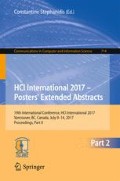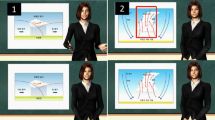Abstract
The goal of this study is to clarify how students’ learning styles give effects to their learning experience and behaviors while visual contents presented at high speed. In our experiment, participants (10 visual learners and 9 verbal learners) categorized by Felder’s index of learning styles learned information science by watching the video content composed of 6 slides. The participants watched the content on the YouTube and used variable-speed playback functionality: 0.5×; 1.0×; 1.25×: 1.5×; 2.0× and we recorded participants’ behaviors by using video cameras and measured how long they spent using the functionality. We applied ANOVA to the participants’ scores on the comprehension test, mean responses for the questionnaire, and the mean percentage of functionality-usage time duration. The comprehension test results indicated no signify discrepancies between visual learners and verbal learners. Questionnaire survey showed that verbal learners felt significantly less difficulty on the slide 2. The functionality usage time duration indicated that verbal learners spent significantly longer time duration watching the video content at 2.0× speed. Those findings suggest the possibility that verbal learners tend to use the hi-speed playback functionality longer than visual learners when they feel less difficulty on educational slides.
You have full access to this open access chapter, Download conference paper PDF
Similar content being viewed by others
Keywords
1 Introduction
As the popularity of massive open online courses (MOOC) continues to grow worldwide in recent years, research efforts dedicated to studying the learning processes of course participants continue to increase. Guo et al. who analyzed a dataset containing some 7 million instances of students watching visual content on MOOCs [1]. Their results indicated that the number of course participants paying attention to an image-based content stream begins to decrease significantly when the content streams of duration are longer than 6 min and instructors’ speaking rates are fairly slow. Nagahama and Morita studied the efficacy of using variable-speed playback functionality to present visual content at high speed and indicated that content playback speed variation: 1.0×; 1.5×; 2.0× did not affect learning outcomes [2].
Felder’s index of learning styles (F-ILS) is an online survey instrument used to assess preferences on four dimensions: active-reflective; sensing-intuitive; visual-verbal; sequential-global of a learning style model [3]. F-ILS has been used for researches that examine the relationship between learner characteristics and learner behaviors [4, 5]. To date, however, there have been few studies of clarifying the relation between students’ learning styles and effects of using content playback speed variation functionalities. The goal of this study is to clarify how students’ learning styles give effects to their learning experience and behaviors while visual contents presented at high speed.
2 Methods
2.1 Visual Content
The visual content was same as the one used in the experiment by Nagahama Morita [2]. The theme of the content was the network infrastructure of a high school information science department. The time required to play back the content was 8 min and 34 s (8:34). The content was composed of 6 educational slides and uploaded on the YouTube. YouTube has the variable-speed playback functionality and offers a choice of five playback speeds: 0.5×, 1×, 1.25×, 1.5×, and 2×. The following Table 1 gives a summary of the educational slides. Mora is a unit of Japanese words.
2.2 Experiment
In our experiment, participants (10 visual learners and 9 verbal learners) categorized by F-ILS. First, before presenting any visual content, we give students a comprehension test (the pre-lesson test) to assess their pre-existing knowledge of the educational material in the visual content. Next, participants practiced using variable-speed playback functionality watching the pre-video content so that they get used to the experimental environment. Then, they learned about the network infrastructure while we recorded they behaviors by using video cameras and measured how long they spent using the functionality. After viewing the visual content at various speeds, we set a post-lesson test and questionnaire. The questionnaire asked how much they felt difficulty to each slide.
3 Results and Discussion
3.1 Analysis of Comprehension Test
We determined the overall score and conducted a two-factor mixed-model ANOVA using the learning styles as one factor (F-ILS factor) and pre-lesson vs. post-lesson as the second factor (pre/post factor). Table 2 shows the mean scores on the comprehension tests with the ANOVA results.
Here interactions were not significant (F(1, 17) = 0.06, n.s., partial η 2 = 0.00, power = 0.07). An analysis of primary effects indicated a significant trend toward the F-ILS factor (F(1, 17) = 0.13, n.s., partial η 2 = 0.00, power = 0.07). On the other hand, statistically significant differences were found with respect to the pre/post factor (F(1, 17) = 143.38, p < .01, partial η 2 = 0.89, power = 1.00).
3.2 Analysis of Educational Slides’ Difficulty
We applied a single-factor ANOVA to the mean responses for the questionnaire (see Fig. 1). The results on the slide 1 indicated no significant discrepancies between groups (F(1, 17) = 0.09, n.s., effect size f = 0.07, power = 0.06). The results on the slide 2 indicated significant discrepancies between groups (F(1, 17) = 4.68, p < .05, effect size f = 0.52, power = 0.58). The results on the slide 3 indicated no significant discrepancies between groups (F(1, 17) = 0.12, n.s., effect size f = 0.08, power = 0.06). The results on the slide 4 indicated no significant discrepancies between groups (F(1, 17) = 0.34, n.s., effect size f = 0.14, power = 0.09). The results on the slide 5 indicated no significant discrepancies between groups (F(1, 17) = 0.04, n.s., effect size f = 0.05, power = 0.06).
3.3 Analysis of Functionality-Usage
We applied a single-factor ANOVA to the mean percentage of the functionality-usage time duration. Table 3 shows the mean percentage of the time duration (except for 0.5× usage-time duration which lacked enough data). The mean percentage of 2.0× usage-time duration (see Fig. 2) on the slide 2 indicated significant discrepancies between groups (F(1, 17) = 5.21, p < .05, effect size f = 0.55, power = 0.62).
4 Conclusion
The goal of this study is to clarify how students’ learning styles give effects to their learning experience and behaviors while visual contents presented at high speed.
In our experiment, participants (10 visual learners and 9 verbal learners) categorized by Felder’s index of learning styles learned information science by watching the video content composed of 6 slides. The participants watched the content on the YouTube and used variable-speed playback functionality: 0.5×; 1.0×; 1.25×: 1.5×; 2.0× and we recorded participants’ behaviors by using video cameras and measured how long they spent using the functionality.
We applied ANOVA to the participants’ scores on the comprehension test, mean responses for the questionnaire, and the mean percentage of functionality-usage time duration. The comprehension test results indicated no signify discrepancies between visual learners and verbal learners. Questionnaire survey showed that verbal learners felt significantly less difficulty on the slide 2. The functionality usage time duration indicated that verbal learners spent significantly longer time duration watching the video content at 2.0× speed. Those findings suggest the possibility that verbal learners tend to use the hi-speed playback functionality longer than visual learners when they feel less difficulty on educational slides.
References
Guo, P.J., Kim, J., Rubin, R.F.: How video production affects student engagement: an empirical study of MOOC videos. In: Proceedings of the First ACM Conference on Learning, pp. 41–50 (2014)
Nagahama, T., Morita, Y.: An analysis of effects of learning with high-speeded visual contents. Jpn. J. Educ. Technol. 40(4), 291–300 (2016)
Felder, R.M., Henriques, E.: Learnig and teaching styles in foreign and second language educatin. Foreign Lang. Ann. 28(1), 21–31 (1995)
Morita, Y., Koen, V., Ma, G., Wu, Z., Johendran, A.: Pilot study of the relationship between learning progress and learning style in web-based PSI course. In: Proceedings of World Conference on e-Learning in Corporate, Government, Healthcare, & Higher Education (E-Learn), pp. 2243–2248 (2005)
Oyama, M., Murakami, M., Taguchi, M., Matsushita, K.: An analysis of students’ learning behaviors using e-learning materials: focusing on students’ learning styles. Jpn. J. Educ. Technol. 34(2), 105–114 (2010)
Author information
Authors and Affiliations
Corresponding author
Editor information
Editors and Affiliations
Rights and permissions
Copyright information
© 2017 Springer International Publishing AG
About this paper
Cite this paper
Nagahama, T., Morita, Y. (2017). An Analysis of Students’ Learning Behaviors Using Variable-Speed Playback Functionality on Online Educational Platforms. In: Stephanidis, C. (eds) HCI International 2017 – Posters' Extended Abstracts. HCI 2017. Communications in Computer and Information Science, vol 714. Springer, Cham. https://doi.org/10.1007/978-3-319-58753-0_24
Download citation
DOI: https://doi.org/10.1007/978-3-319-58753-0_24
Published:
Publisher Name: Springer, Cham
Print ISBN: 978-3-319-58752-3
Online ISBN: 978-3-319-58753-0
eBook Packages: Computer ScienceComputer Science (R0)






